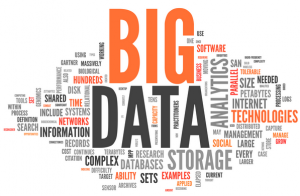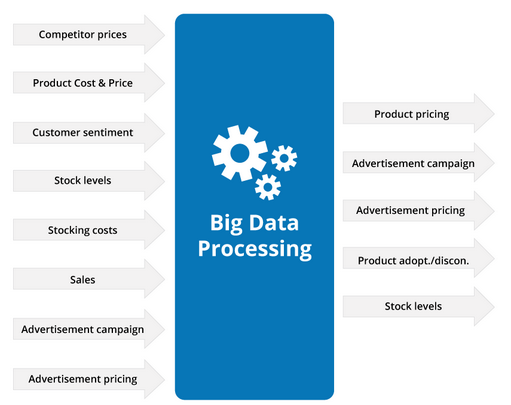Big Data in E-Commerce

Big data is gradually changing the digital world around us. Opportunities, previously available only to the largest market players, are now common to their smaller counterparts. E-commerce is already inconceivable without big data. So what does this term mean? What impact does the growth of big data provide on the business? Why big data analytics is important for e-commerce? How to use big data analytics in online retail? What are the sources of big data for analytics in e-commerce? What is the future of big data in e-commerce? You will find answers to all these questions below.

Table of contents
What is big data?
Big data is a broad term used to describe the flow of digital data, which is constantly growing and becoming more and more available. Big data consists of both structured and unstructured information and covers all possible business activities. Being a product of technical progress, it may become as important as the Internet is now. More data leads to more accurate analyses, which is good for business, science and society. The only problem is the inability of traditional data processing applications to work with the new volumes.
Challenges related to big data include search, capture, curation, storage, analysis, visualization, sharing, and privacy of information. The good data analytics solution should be able to deal with them successfully. Accurate analytic output leads to better decisions. In their turn, better decisions are often the reason on higher efficiency, reduced costs and risks.
Everyday millions of devices produce tons of data. Smartphones, tablets, desktop computers, IoT, wireless sensor networks, RFID readers, and other gadgets generate information about everything. The per-capita data storage capacity doubles within 40 months. The challenge for every enterprise is to determine what information from this flow is useful and what is the best possible way to utilize it.
The most common characteristics used for the description of big data are volume, variety, velocity, variability, veracity, and complexity. With their help, you can get better understanding of every massive data set, which is necessary for its more efficient utilization.
-
Volume shows the quantity of generated data. This characteristic determines how big is the set of received data.
-
Variety provides information about the category to which big data belongs. The understanding of this characteristic is extremely necessary for more effective use of big data.
-
Velocity shows the speed of data generation, which is important for subsequent processing.
-
Variability describes the level of inconsistency. With the help of this parameter, you can get more accurate output.
-
Veracity shows the quality of big data and influences the accuracy of analysis.
-
Complexity is something between velocity and variety. It provides understanding of data volumes and number of sources used in generation of certain big data massif.
Why big data is so important
With the help of big data you can optimize the existing offering. It also provides the ability to reduce costs of different processes within the enterprise. Moreover, big data can be utilized for the development of new products. In other words, it is a core of smart business decisions.
Luckily, there are no any problems in acquiring giant amounts of data. They are in the ability of organizations to take it from all possible sources, get the relevant information, and analyze it to make the correct decisions. Data & analytics are inseparably connected, so you should take the most out of this tandem.
For instance, you can determine core reasons of different problems within short periods of time. Big data combined with powerful analytics software can provide you with the necessary information in near-real time. As a result, you can reduce the volume of issues, failures, and defects.
At the same time, big data can be used for the optimization of routes in real time. The relevant information about traffic conditions, can save delivery vehicles from traffic jams while they are on the road. Fraudulent behavior can be also detected with the help of big data and appropriate software.
A separate source of big data is formed by SKUs. Analyzing it, you can easily determine prices that maximize profit. There are also a lot of m-commerce opportunities of generating coupons and sending tailored recommendations to the customers with the help of big data. Moreover, you can recalculate the portfolio of all your risks within minutes. Keep in mind, that these are just a few random examples, which illustrate big data importance. The practical use of big data is much wider.
Big data in action
UPS shows a good real life example of big data usage. The company began to capture information about different activities in 80s. Now it tracks data on millions packages every day and stores over 16 petabytes of data. UPS relies on telematics sensors from thousands vehicles to capture relevant big data. The company gathers information about speed, direction, and even performance of braking and drivetrain of its trucks.
Thus, UPS receives the information about daily performance, and at the same time gets the ability to redesign route structures in real time. To make this possible, the company also uses data from online maps.
Reconfiguring pickups and drop-offs in real time, UPS significantly reduces its daily costs. For example, in 2011 the company cutted off 85 million miles of routes and saved 8.4 million gallons of fuel.
Big data and e-commerce
The number of online businesses is rapidly growing. As a result, the competition is increasingly aggressive. To stay profitable, companies need new competitive advantages, and big data provides a lot of them. Relying on big data analytics, e-commerce retailers can stay ahead of those market players, who still don’t do this or utilize the new trend in less efficient manner. Big data analytics has a lot of advantages over traditional market analytics, because it provides much more opportunities, such as deeper insights into customers behaviour; more efficient strategic decisions; more accurate price range, etc.
Such information as names, addresses, and contact details is not enough for predicting the behaviour of customers. Luckily, big data covers much wider range of information, which can help you with precise predictions and personalisation of your services. As a result, you will be able to design product propositions and e-commerce marketing strategies which are closer to the needs of your target audience. Moreover, personalisation is among key e-commerce trends in 2015. Keep in mind, that, it delivers faster return on investments and increases sales.
Big data also helps in taking strategic decisions on all levels of the enterprise. The flow of relevant information forms a very reliable base for all business steps, so all the decisions lead to better results.
Another important aspect of using big data in e-commerce is dynamic pricing optimisation, which is impossible without constant data flow on other market players.
As you can see, the only way for e-commerce retailers to keep up with the market is to adapt their businesses for the use of big data.

How to adapt e-commerce business for the use of big data
First of all you have to determine improvements to your e-commerce website. In order to achieve this, you should understand the following:
-
what information is important to you business;
-
what are its sources;
-
how should your website interact with them;
-
how can it interact with them;
-
how can you utilize this information for the needs of your e-commerce business.
You can use an A/B testing to check what improvements are better.
Besides specific needs of your e-commerce business, there are some general cases of use for big data. For example, you can predict peaks and troughs with the help of information about your customers behaviour. Of course, such predictions differs from market to market, but peaks and troughs are typical for every e-commerce retailer. By analyzing customers’ habits and combining that information with internal data, you will get a clear representation of how holiday rush impacts revenue, inventory management, shipping, and customer services.
There are also great opportunities for big data analytics in supply chain. With the understanding of peaks and troughs, e-commerce merchant can utilize big data for the successful inventory management. The result is a new competitive edge over other market players. Moreover, big data can be used to gain real-time updates, such as product pricing.
And don’t forget about the aforementioned personalisation. Whatever business you are running, personalization is always important. As an e-commerce store owner, you always have to think how to get the new customers and make the existing ones more loyal. With the help of big data and analytics tools, you can personalize the experience of every user as much as possible. This leads to higher conversion rate and additional traffic. Another aspect of e-commerce personalisation is the ability to discover where traffic is coming from. Such information is necessary for different activities outside of your e-commerce store. In this case, personalization helps essentially reduce spending on the marketing.
To avoid common mistakes, we also recommend you to pay your attention to the below advices:
-
Don’t use another company’s technique in its initial form. Even the closest e-commerce businesses have a lot of different aspects.
-
Try to determine your problems and improve them. This is the only way to adapt your e-commerce business for the use of big data.
-
Start with something small. Big attempts fall much further.
-
Develop your own approach to big data gradually. Rely on A/B testing and other techniques.
-
Adopt the existing analytics strategies for your needs.
Data sources
Every e-commerce business has an access to numerous sources of big data, which vary in type and sometimes are difficult to integrate with the existing online store. Relevant sources of big data include competitor offers, cost of products, their prices, level of stocks, sales data, all possible aspects of advertising, customers data, etc. They are available in lots of forms and require different approach to utilization within e-commerce web-site.

Sources of big data
Comparison websites can be used as a source of competitor offers. Such websites often sell datasets with the important big data, which can be stored in a form of files. Additionally, you can get the access to it via API. Moreover, you can rely on crawling services, SQL and NoSQL stores to capture information about competitor offers.
If you are looking for the information about cost of products, their prices, level of stocks, sales data, you should connect to business’s SQL data store. Small e-commerce websites rely on Excel and CSV files to store this information. Such aspects of advertising as campaign and pricing data is often available through APIs.
The largest source of information about customers is social media. Such data is often collected in a raw form, then it is processed, and stored. You can also rely on different services to get this kind of big data.
Big tools for big data
As an e-commerce store owner, you can choose among dozens of data gathering and analytics tools. The most reliable solution is Fanplayr, but it has a lot of analogs, which are also able to gain relevant information about sales, competitors, and customers. In your attempts to utilize big data within e-commerce business, check several tools, because most of them have unique features, but only one can be winning for your certain case.
Fanplayr is designed to create, execute, and optimize your business strategy. The platform utilizes big data to provide your customers with right offers at right time. Fanplayr relies on a robust segmentation engine, it also provides package for in-depth analytics, and has a team of experts.
With Kissmetrics, you will get all data required for better decision making. Being a person-based analytics platform, it provides information about products, sales, marketing, customers, etc. The tool connects all this data to a single person. As a result, you are able to see the entire way of your customer to your e-commerce store, and implement successful strategies, based on this knowledge.
Spring Metrics provides its customers with 2 tools: Conversion Analytics and Smart Conversions. First one provides the ability to review site traffic and segment data. The second tool is designed to engage visitors with real time offers based on big data.
Woopra is another big data analytic solution. It tracks both new and unidentified users to provide you with relevant information about their activities on your e-commerce website. As a result, you are able to make better business decisions. In addition, Woopra is able to measure campaigns in real-time.
Quantcast searches sites for demographic and traffic big data for free. The platform also delivers real-time advertising. If you are looking for the opportunity to get inside your web and mobile audience, Quantcast can be useful.
With Compete’s solution, you will get relevant big data on engagement, traffic, and demographic. The platform also provides information on keywords that are driving traffic to your e-commerce store. In addition, you will be able to discover more about tactics of your competitors. Compete helps understand which marketing strategies are the best for your e-commerce enterprise, which tactics are ineffectual, and what are untapped possibilities.
Webtrends helps you understand big data. The platform is developed to engage your visitors and increase conversions. Webtrends provides support for multiple channels and works in real time. As a result, you get data-driven relevant marketing insights. You can integrate Webtrends with all your products and platforms with ease. The solution is highly scalable, so it can grow with your business.
How big data will change e-commerce
As you can see, big data covers all aspects of modern e-commerce. Its provides information about everything, and this information is accessible to everyone. New opportunities will change e-commerce in recent years. Below you will find a few most common predictions.
In combination with deep learning (a branch of machine learning), big data is able to enhance e-commerce with natural language processing, image recognition, language translation, and automatic speech recognition.
Natural language processing in e-commerce was introduced in 2008. It was a Firefox extension capable for filtering Amazon reviews in order to create a summary of pros and cons. With the help of big data and deep learning, e-commerce will receive a new powerful tool. Imagine, customers using voice queries to find uncertain goods. The system will not only ask questions, but recognize emotional signals to provide personalised offers. Sounds like sci-fi, but it is one of the most possible aspects of e-commerce future.
Image recognition is another possible opportunity for e-commerce. Google is already working on it, and other media giants are not far behind. For instance, Pinterest acquired a new visual search technology. Instead of user keywords, it identify images that match other images. Such functionality can be implemented within e-commerce store. As a result, customers will be able to upload photos right from their smartphones to find the desired products.
Amazon introduced a patent for “anticipatory shipping.” According to this feature, the goods will be shipped before they have even been placed. It is still a patent, but its implementation is possible due to big data available to Amazon. Chances are, we will witness a day, when the technology will go far ahead, and anticipatory purchases will become a normal feature of most e-commerce websites.
Volumes of big data are constantly growing, at the same time the utilization of the received information becomes more smart. Natural language processing, image recognition, and other processes illustrate this tendency. All new technologies are in development, but we have no doubts that e-commerce will adopt them for its needs in nearest future.









